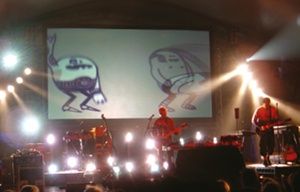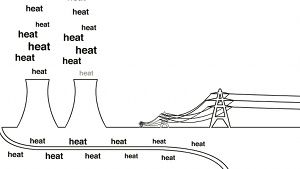RIP Airside
After 14 years of creativity, optimism fun and plain old hard work, this widely loved London studio is packing it in. We talk to the founders about tears, giggles and the future
Studio Life visits Airside! Find our exclusive documentary at the foot of the page.

Not long after Airside announced its closure in November 2011, the studio’s three founders gave a talk at design event See No Evil in London. A video showing some of its best work wowed the audience, accompanied by music mixed by Fred Deakin. After the music faded, his voice filled the room: “Airside have left the industry.” For members of the company – and some in the audience too – it was tough to choke back a tear.
So what’s the purpose of this article – why profile a studio that’s closing? Is it an obituary? A eulogy, perhaps? Well, Airside was such a positive, optimistic and popular outfit that we can hardly approach it so morbidly. This is definitely a celebration rather than a funeral.
“We wanted to make people feel happy,” says co-founder Nat Hunter. “And we realised that if we made people feel happy, then that made us happy. Whether that was someone experiencing our work, clients coming to us and feeling like we’ve done a good job for them, or someone working in our studio who felt like it was a good place, we intentionally wanted the world to be a happier place.”

The studio’s work exudes this positive attitude: the Airside aesthetic is all about wonderful colours, clean lines, playful humour and two scoops of fun. The look was no accident, either. When Hunter and Deakin launched the company with Alex Maclean in 1998, Tomato, Neville Brody and Raygun magazine were the heroes of design. It all seemed dark and masculine; cool and inaccessible. Airside set out to make people smile without pretence: “We weren’t very interested in melancholy, cool, style and using whatever was the latest thing,” explains Maclean. “It was much more about a very open spirit – a spirit of adventure, innovation, humour and engagement.” This openness chimed with like-minded designers, and today you can often see a touch of Airside’s style in work across the industry and around the world. As a testament to its success, it even has a studio in Japan that will carry on the legacy after Airside UK locks up for the last time in March.
While it’s easy to spot its aesthetic influence, let’s not overlook the substance Airside brought to its work. A-list clients like Sony, Barclaycard, The Times, Greenpeace and Fiat aren’t just looking for cute characters and rainbows: they want creative that gets results. Airside’s designers are experts in areas like interactivity and narrative – things that really engage audiences. Just look at the studio’s umpteen industry awards.

One of its latest major projects was a redesign of Virgin Atlantic’s in-flight experience. Going well beyond sticking on a video during long-haul flights, it draws passengers in: “They’re so absorbed with it, they forget to order drinks,” laughs Hunter. “I like it when design has a positive impact on the world – people are happy so they’re ordering fewer drinks, Virgin is happy because its bar bill goes down, and also it has less alcohol to carry so its fuel bill goes down.”
Just how much work has Airside done? Well, the Islington-based studio has produced over 100 films, commercials and animations, and 49 major websites. There have been 268 client projects, generating an archive of nearly 10 million files since 1998. And let’s not forget the T-shirts, those cool calendars with the little stickers, and toys like the Dotcom Refugees.

That’s a lot for a studio that’s never been massive. At its peak, Airside had 16 permanent employees. Internally the directors have – almost to a fault – replicated the happy-go-lucky aura that Airside has exuded publicly. “The quality of life for people who worked here was more important than the bottom line, and we pursued that at all costs,” says Maclean. Making money was a nice by-product of a happy working environment and a positive working relationship.”
The fantastic atmosphere came at a price. When the dot-com bubble burst in 2001, Airside nearly went bust. And again in 2004, 2007 and 2010. Each time it’s taken a monumental effort to rescue the situation. For the founders, this has meant putting aside their creative ambitions to chase down the pounds, dollars, yen and groats required to keep the good ship afloat. Airside isn’t closing due to financial pressure, but when it’s gone the founders will be released from that obligation and free to explore new creative avenues.
A key reason why Airside is splitting up is simply due to changes in the industry. The studio started as just three creatives with Macs wanting to collaborate like artists in a studio. Paints and easels were replaced with keyboards, mice and scanners. They were unique in 1998. Their desire was to create illustration, motion graphics, websites and print projects all at once, at a time when big production companies were using pneumatic tape and didn’t know what an email attachment was, let alone a website. Now there are vast numbers of studios just like Airside.

Each founding member wants to do something new, and they all have different plans: “There’s been a big change in the world. I don’t know if we were responsible for it, but that change is now done,” says Deakin. “If I was going to start a design company tomorrow I don’t think it would look very much like Airside. There’s an instinct to create something new and when everyone’s doing the same thing, I kind of go in the other direction.”
Computer Arts has grown up alongside Airside, and we’ve always loved its approach. What it’s done for the industry is commendable. “It will be sad but we know it’s time,” says Hunter. “It feels right and new opportunities are already coming our way, but it will stay with us. It will be part of our identities for the rest of our lives.” We’re sorry to see it go. RIP, Airside.

Thank you for reading 5 articles this month* Join now for unlimited access
Enjoy your first month for just £1 / $1 / €1
*Read 5 free articles per month without a subscription

Join now for unlimited access
Try first month for just £1 / $1 / €1
Get the Creative Bloq Newsletter
Daily design news, reviews, how-tos and more, as picked by the editors.
The Creative Bloq team is made up of a group of design fans, and has changed and evolved since Creative Bloq began back in 2012. The current website team consists of eight full-time members of staff: Editor Georgia Coggan, Deputy Editor Rosie Hilder, Ecommerce Editor Beren Neale, Senior News Editor Daniel Piper, Editor, Digital Art and 3D Ian Dean, Tech Reviews Editor Erlingur Einarsson and Ecommerce Writer Beth Nicholls and Staff Writer Natalie Fear, as well as a roster of freelancers from around the world. The 3D World and ImagineFX magazine teams also pitch in, ensuring that content from 3D World and ImagineFX is represented on Creative Bloq.
